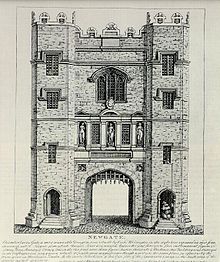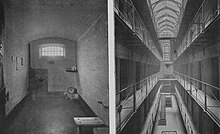Newgate Prison
The Newgate Prison ( English : Newgate Prison ) in London was one of the most notorious prisons in English history (1188-1902).
history
The prison was built in 1188 at the Newgate city gate on behalf of King Henry II and was considerably enlarged in 1236. It served various purposes, including the detention of convicts awaiting execution of the death penalty . The escape protection was not always guaranteed. In 1255 the prisoner John Offrem, who was imprisoned for the murder of a prior , managed to escape. King Henry III was so angry that he had the responsible sheriffs thrown into the Tower and imposed a fine of 3,000 marks (about 4,000 pounds) on the city. The robber Jack Sheppard managed to escape Newgate three times before he had to go to the gallows in 1724 .
The old prison was finally torn down, so that between 1770 and 1778 a new one with a chilling facade made of rough-hewn masonry - designed by the architect George Dance the Elder. J. (* 1741; † 1825) - could be built. As early as 1780, however, it was attacked by insurgents during the Gordon Riots and set on fire. Many prisoners died in the flames and around 300 were able to escape temporarily. Two years later, Newgate was rebuilt again.
In 1783 the London gallows were moved from Tyburn to the Newgate compound. The spectacle of the executions always attracted large audiences.
The social reformer Elizabeth Fry (* 1780, † 1845) protested from 1813 against the inhumane prison conditions in Newgate and called for improvements, which, however, could only be implemented very gradually. It was not until 1858 that the interior was equipped with individual cells.
As of 1868, executions were carried out inside Newgate prison walls. The prison was closed in 1902 and demolished in 1904. Today the Old Bailey Criminal Court stands on the property .
Famous inmates
- Owain ap Maredudd ap Tudur , entered into English history under the anglicized name Owen Tudor, (* approx. 1400; executed 1461 in Hereford during the English Wars of the Roses ), was the progenitor of the House of Tudor . He was a Welsh soldier and courtier who secretly married the widow of England's King Henry V , Catherine of Valois , and thus had a role in the establishment of the Tudor dynasty. The marriage only became known with her death in 1437. Owen Tudor was incarcerated in Newgate Prison but was soon able to escape under circumstances that were not entirely clear.
- Oliver Plunkett (1625–1681), Archbishop of Armagh and Irish primate , is considered the last Catholic martyr in England and was incarcerated in Newgate Prison before his execution on July 1, 1681 in Tyburn. Its supposedly original cell door is kept - among other relics - in St. Peter's Church of Ireland in Drogheda . His fellow prisoner, friend and pastoral companion was the Benedictine Maurus Corker .
- William Kidd (1645–1701), a pirate of Scottish origin, was imprisoned in Newgate Prison from May 1700 during his murder trial. He was hanged on May 23, 1701 at the Execution Dock in the London Thames area of Wapping .
- Rob Roy (aka Robert Roy MacGregor ) (1671-1734), a Scottish folk hero and "Highland outlaw" whospent a few years in prison in Newgatein the 1720s . Shortly before he was to bedeportedto Barbados in 1727, he was pardoned and spent the rest of his life in Inverlochlarig Beg, near the Scottish village of Balquhidder.
- Jack Sheppard (1702–1724), an English robber, managed to escape from Newgate three times in 1724 alone before he was hanged in Tyburn on November 16 of the same year with great sympathy from the London public. His successful escape attempts have secured him the reputation of an English escape king to this day.
- Jonathan Wild (1683–1725), an English criminal who led a double life as the leader of a gang of thieves and appeared in public as the “general thief of Great Britain and Ireland” . In 1725 his double life was exposed and he was sentenced to death. He spent his last days in Newgate Prison. Daniel Defoe reports that the crowd gathered for his execution was the largest ever in London.
- Sarah Malcolm (1710–1733), a robbery murderess, washanged on Fleet Street for the circumstances.
- William Dodd (1729–1777), a well-known man of letters, respected London clergyman and former court preacher, who showed certain shortcomings in private life and was hanged in Tyburn on June 27, 1777 for a forged promissory note.
- Lord George Gordon (1751-1793), whohad instigatedthe Gordon Riots in1780, was convicted in 1787 of insulting the French queen and the French ambassador. In January 1788 he started a five-year prison sentence in Newgate, but he was able to make it pleasant with celebratory meals and dances. Since he could notofferthe necessary "guarantees for faultless behavior" at the end of his prison term, he stayed in Newgate and died there on November 1, 1793.
Newgate in horror fiction and novels
Since the early eighteenth century numerous publications have appeared which, under the pretext of moral instruction and educational exhortation, presented the cases of Newgate prisoners - in many cases up to their execution - to the general public. These sensational reports, garnished with macabre details, achieved bestseller editions in England as early as 1750 , which could only be surpassed by the Bible . The popular books, called chronicles or calendars , advertised in the subtitle with keywords such as B. Malefactors' Bloody Register ( Eng . "The culprit bloody directory" ) or Villainy Display'd in all its Branches ( Eng . "Villains, represented in all their varieties" ) and are today all together under the literature term The Newgate Calendar or . Newgate novel summarized.
Newgate Prison also plays a grim role in some of the world's fiction novels, such as: E.g. in Daniel Defoe's Glück und Unglück der Famous Moll Flanders (1722), in Charles Dickens works Oliver Twist (1839), Barnaby Rudge (1841) and Great Expectations (1861) and in Michael Crichton's novel The Great Train Robbery (1975). In the novel series Abby Lynn by Rainer M. Schröder , the protagonist Abby is temporarily imprisoned in Newgate, and in Rebecca Gablé's books , protagonists are repeatedly imprisoned in Newgate for a limited time.
Newgate in the movie
The feature film The Great Train Heist includes an escape from Newgate. Newgate also plays a role in the film V for Vendetta .
literature
- Anthony Babington: The English Bastille. A history of Newgate Gaol and prison conditions in Britain, 1188-1902. Macdonald, London 1971, ISBN 0-356-03802-5 .
- Michael Crichton : The Great Train Robbery. Avon Books, New York NY 2002, ISBN 0-06-050230-4 .
- Daniel Defoe : luck and misfortune of the famous Moll Flanders. Those born in Newgate Penitentiary ... Described from their own memories. German by Martha Erler. With illustrations by William Hogarth and an essay by Norbert Kohl. 1st edition, reprint. Insel-Verlag, Frankfurt am Main et al. 2002, ISBN 3-458-32407-0 ( Insel-Taschenbuch 707).
- Charles Dickens : Barnaby Rudge. (Or the War of Faith in London. Historical novel). Translated into German by Paul Heichen. Newly reviewed, edited and annotated by Anke Schäfer, Edgar Bracht. With an afterthought by Stefan Bauer. Bastei-Verlag Lübbe, Bergisch Gladbach 1997, ISBN 3-404-13841-4 ( Bastei Lübbe 13841 general series = classics of the historical novel ).
- Charles Dickens: Great expectations. Translated from English, with comments and afterword by Ulrike Jung-Grell. Reclam, Stuttgart 1993, ISBN 3-15-021562-5 ( Universal Library 1562).
- Charles Dickens: Oliver Twist. Novel. Translated from the English by Carl Kolb and Anton Ritthaler. With illustrations by George Cruishank and an afterword by Uwe Böker . Artemis and Winkler, Düsseldorf 2001, ISBN 3-538-06930-1 ( Winkler Weltliteratur - Blue Series ).
- Charles Dickens: Oliver Twist. Novel. German by Gustav Meyrink . 12th edition. Diogenes-Verlag, Zurich 2005, ISBN 3-257-21035-3 ( Diogenes-Taschenbuch 21035 detebe-Klassiker ).
- Stephen Halliday: Newgate. London's Prototype of Hell. Sutton Publishing, Stroud 2006, ISBN 0-7509-3895-1 (Stephen Halliday is a Professor at Buckinghamshire Chilterns University College and a non-fiction author. He tells the history of Newgate Prison from its inception, its inmates and their punishments, and its conversions and its reforms).
- Dietmar Kruczek: The "Angel from Newgate". the life of Elizabeth Fry. Aussaat-Verlag, Neukirchen-Vluyn 1996, ISBN 3-7615-4924-5 .
- John Milsome: The heroine of Newgate. The story of Elizabeth Fry. Lutterworth, Cambridge 1987, ISBN 0-7188-2677-9 ( Stories of faith and fame ).
- The Newgate calendar Introduced by Clive Emsley. Wordsworth Editions, Ware 1997, ISBN 1-85326-774-0 ( Wordsworth Classics of World Literature ).
- Andrew Pepper: The Last Days of Newgate. Weidenfeld & Nicolson, London 2006, ISBN 0-297-85237-X (detective novel against the backdrop of Victorian England).
Web links
- victorianlondon.org - Numerous literature citations and photos related to Newgate Prison
References
- ^ Frederick Ross: Bygone London, 1892 online in the Google book search
- ^ The Newgate Calendar
Coordinates: 51 ° 30 ′ 57 ″ N , 0 ° 6 ′ 7 ″ W.


